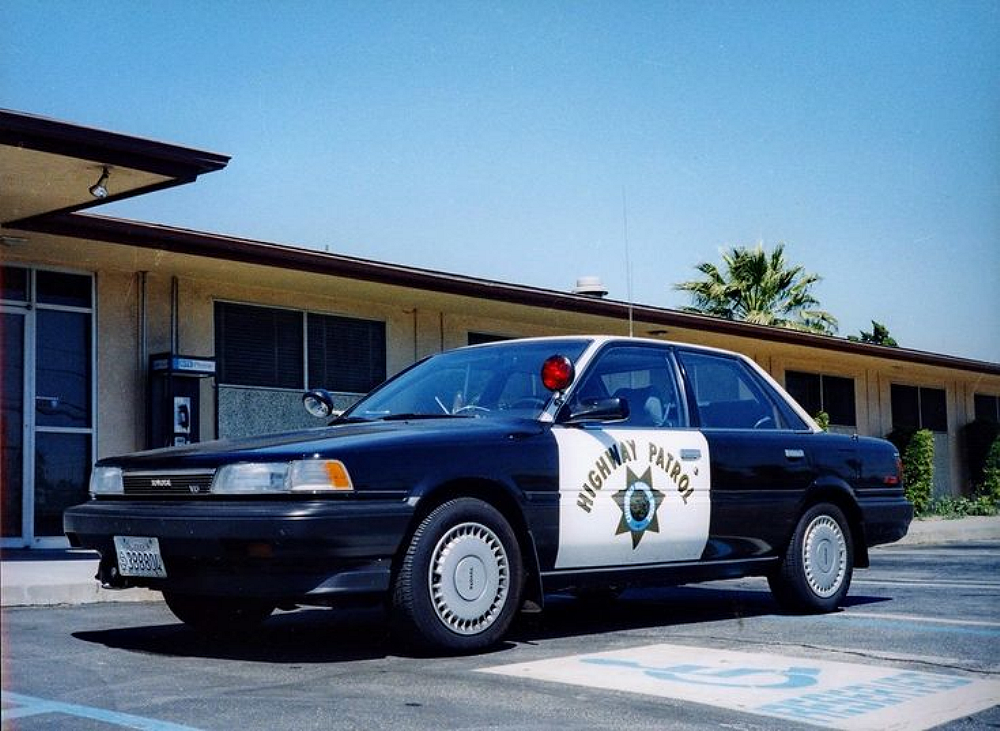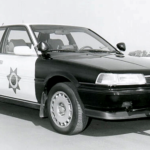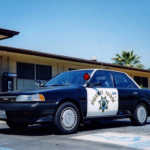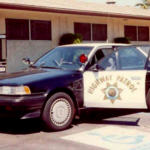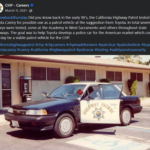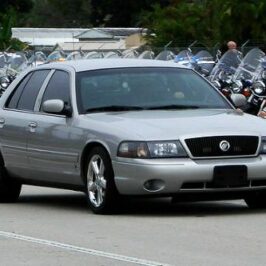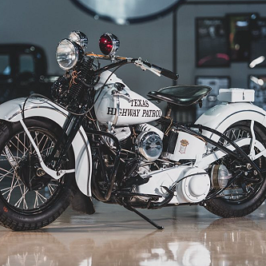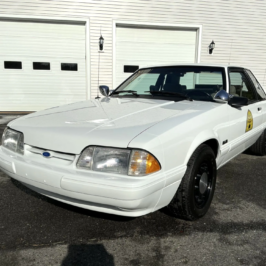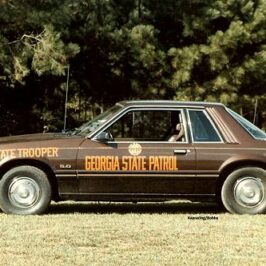It’s not uncommon for large law enforcement agencies to test police package vehicles being offered by the various car manufacturers. In 1989, Toyota wanted to get into the police car market and offered to build the CHP pursuit-rated Toyota Camry’s to replace their gas-guzzling Dodge Diplomats, Chevrolet Caprices, and the legendary Ford Mustang SSP. As a formality, Toyota would sell the CHP seven Camry’s for one dollar ($1.00), and buy them back for one dollar when the CHP was done with them.
To better equip the Camry for police work, Toyota sent a fleet of JDM (yes, these test Camrys were from Japan) Camrys to Toyota’s race facilities in Torrance. Though state law reportedly prohibited using foreign-made cars on the force, Toyota was building Camrys in Georgetown, Kentucky by that time.
The CHP also gave an 80+ list that the vehicle must be equipped with and modified to perform. The must list included: standards for acceleration, sustained top speed, an hour idle capability, slalom course agility, electrical reserve: stand-by (engine off) and full chase (siren/lights on), 250 lbs. seat standard w/ easy access (to accommodate side firearms!), tire specifications, among other things.
While we don’t know what the setup was for all seven of the cars, we do know that one was a 2.0L 4-cylinder turbo sedan with all-wheel-drive, and another was a 2.5L V6 front wheel drive sedan.
The 2.0L Turbo AWD Car
The 2.0L turbo car used the 3S-GTE 2.0L Turbo engine out of the Toyota Celica GT-Four (the same one from the MR2 and the World Rally Championship (WRC) Celica) and was factory rated at 182 horsepower which was a big jump from the Camry’s stock 2.0L 4-cyliner rated at 115 horsepower. But Toyota didn’t stop there. They added HKS bolt-ons, bored out the CT26 turbo to fit a larger compressor wheel, used a programmable ECU from Nippon Denso, and boosted the turbo from 3 psi to 5 psi. It’s estimated that the modifications boosted the engines output to around 280-300 horsepower.
The car also featured a 5-speed manual transmission, an all-Trac fulltime four-wheel drive system, limited slip differentials, TRD/TTE rally suspension, struts with TRD shocks and springs based on the WRC (but with 2-inches of extra ride height to make up for the Camry’s heavier weight), larger 15-inch steel wheels, Goodyear tires, and low-bolstered Recaro seats. It was practically a rally car under that black and white CHP body.
The 2.5L V6 FWD Car
The Camry came with Toyota’s new 2.5L V6 rated at 160 horsepower. Fully loaded with two people, the pursuit-rated Camry could hit 112 MPH in just two miles. The Dodge Diplomat also reaches 112 m.p.h., while the Chevrolet Caprice can get to 120 m.p.h., and the Mustang, which is used for high-speed chases, can reach about 130 m.p.h.
This car was likely upgraded with a heavy-duty radiator, 15X6 steel wheels, Goodyear tires, HD wheel studs, HD suspension bushings, HD brake pads, TRD Rally springs, shocks and upper strut bars from a Celica, reinforced lower arms and strut housings, hefty sway bars and push bars built by Sway-Away, and Recaro seats with low side bolsters mounted on lowered seat rails.
In The End
In the end, the California Highway Patrol didn’t choose to replace their fleet with the Toyota’s, and Toyota didn’t offer a police package Camry here in the United States.
Since these cars were prototypes, they would have ended up in the crusher when the CHP finished with them and sold them back to Toyota for $1.00 each. But you never know. Every once in a while, you here about a prototype being discovered in someone’s garage that was thought to have been destroyed decades earlier.
While some may think that the idea of a Highway Patrol using a Toyota Camry may seem ridiculous, the Connecticut State Police purchased at least 30 Mazda MX-6s of different colors in 1989 and used them as unmarked patrol cars for catching speeders.
Check out: Connecticut State Police Mazda MX-6.
Someone Should Build A Replica
Restored police vehicles always draw a crowd and there are some pretty big shows that happen around the country. Imagine who cool and unique it would be to recreate the turbo rally car version of this car all decked out as a period correct California Highway Patrol car.
Los Angeles Times – CHP to Give Toyota Camrys a Test Drive
SACRAMENTO – The California Highway Patrol will soon become the first state police force in the nation to use foreign cars when the agency begins road-testing seven Japanese-made Toyota Camrys, CHP officials said Friday.
If the test goes smoothly, the department may buy a limited number of Camrys for use in the mountain foothills by the early 1990s, said Jay Emery, a transportation services manager for the department.
The CHP is testing the Camry at the suggestion of Toyota Motor Sales USA, Emery said. He said the program will cost the state almost nothing because Toyota is selling the cars to the state for $1 each and has agreed to buy them back at the same price in one year. The cars sell at retail for $14,388.
‘Helping Out’
“They have come to us and said they want to build the world’s best police car,” Emery said. “They have asked for our input, and we are helping out.”
Mike Michaels, product news manager for Toyota, said the company decided to develop a police car after getting positive reactions at a recent convention for auto fleet buyers.
“We are not in the police car business,” he said. “We don’t offer anything for sale. Our purpose is to test the waters and evaluate the car’s suitability before we take any more steps.”
A Camry is being tested at the CHP academy in West Sacramento, said Highway Patrol spokesman Sam Haynes. The cars are expected to appear on state highways in about a month.
Haynes said it makes sense for the department to help Toyota develop a police car in case higher gasoline prices or other factors force American companies out of the business.
“American manufacturers might decide they don’t want to be in the enforcement vehicle business,” Haynes said. “In that case, law enforcement may well have to explore other options.”
But Emery said the department has no immediate plans to replace its fleet of Dodge Diplomats, Chevrolet Caprices or Ford Mustangs. If the state does add the Toyota to its patrol car fleet, it will not be until at least 1992.
Because the cars have front-wheel drive, they have better traction in wet and snowy conditions. Emery said the department might consider buying them for use in the mountain foothills where winter conditions vary frequently between snow and dry road. With rear-wheel drive cars, officers waste a lot of time while tire chains are installed or removed.
“We think this will be a very good car for the 2,000-feet to 3,000-feet elevations,” he said.
Although the cars were made in Japan, Emery said he believes the special test arrangement will not violate a state law prohibiting the CHP from using foreign-made vehicles. If the state does buy any Camrys, they will be manufactured at Toyota’s new plant in Georgetown, Ky.
“This is merely a test,” Emery said. “The end result of our test is, hopefully, to develop a good police package for the 1992 Camry.”
Toyota modified the six-cylinder cars at its racing facility in Torrance, adding heavy-duty suspensions, anti-sway bars and auxiliary engine and transmission coolers. The cars also have special push-bumpers, speed-rated tires and heavy-duty upholstery.
The Camry, fully loaded and carrying two people, was able to go from a standing start to 112 m.p.h. in two miles. The Dodge Diplomat also reaches 112 m.p.h., while the Chevrolet Caprice can get to 120 m.p.h., and the Mustang, which is used for high-speed chases, can reach about 130 m.p.h.
Resources:
LA Times – CHP to Give Toyota Camrys a Test Drive
More Photos:

